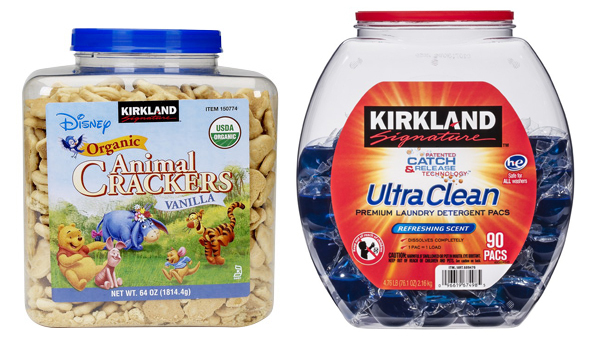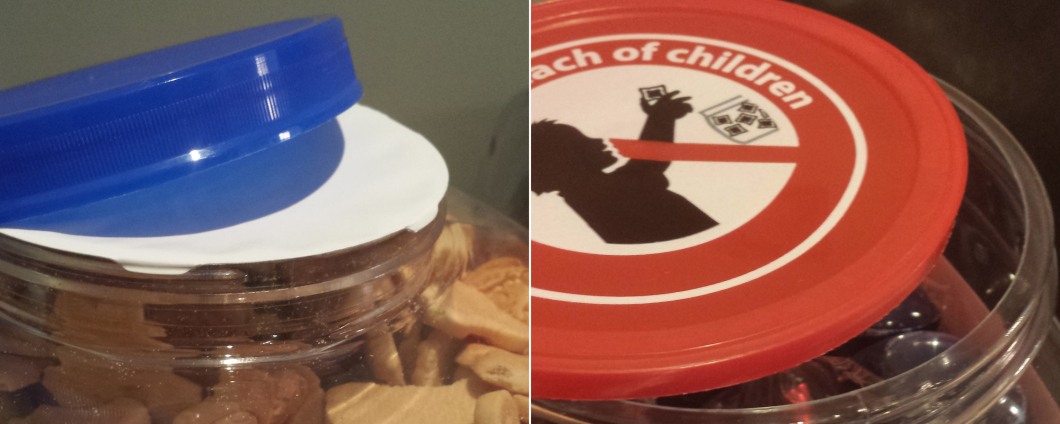Costco’s Animal Crackers Container Is More Secure Than The Store’s Poisonous Detergent Pods

Costco’s Kirkland Signature foods, like the animal crackers on the left, are packaged in screw-top containers, unlike the Kirkland detergent pods with a lid that merely pulls off.
Consumerist readers began tipping us off about about Kirkland pods after our pals at Consumer Reports rated the product higher than Tide and every other detergent in its latest round of testing. These readers believed there was very little difference between detergent container and the plastic tubs Costco uses to sell nuts, cookies, and other snacks.
There is one big difference between the two types of containers — the lid. The food containers, like the animal crackers tub seen in the photos here, are all screw-top lids with a secondary paper seal underneath. During our recent excursion to Costco, we couldn’t find a single Kirkland food product that didn’t have the screw-top lid.
But the detergent tubs, which hold pods full of poisonous chemicals, have only a simple pull-off lid with no secondary seal underneath (though there is a clear plastic band around the lid at the time of purchase). Sure, there is a big warning label to keep this product out of the reach of children, but parents have been ignoring such alerts for years, storing detergent and other hazardous materials in easy-to-reach areas. And you can’t expect a child who doesn’t yet understand the idea of “poisonous” to be able to decipher the warning.
“This is a product with loads of temptation,” a rep for the U.S. Consumer Product Safety Commission tells Consumerist about detergent pods.

The colors and shiny plastic packaging of detergent pods have led to hundreds of children licking, ingesting, and them popping open.
“Steps need to be taken to increase safety, reduce hazards, and put standards in place,” says the CPSC rep.
Within months of those initial reports on kids eating detergent pods, Tide switched to a double-latch lid in an effort to make it harder for babies to pry the packaging open. Even so, there are still reports of children being hospitalized for trying to eat the candy-like pods.
Interestingly enough, while Costco continues to sell its detergent pods in packaging that some readers believe only entices children to investigate, the warehouse chain does voluntarily post a notice from the CPSC alerting customers to the hazards of these products. The CPSC rep confirmed to Consumerist that the alert, while recommended, is not mandatory and not all retailers have elected to post it.
So why would Costco post (albeit several feet above the actual pods being sold) this alert but sell its product in such a candy jar-like container? We have no idea, as the company has ignored our multiple requests for comment on this story.
We did reach out to the American Cleaning Institute, an industry group representing manufacturers of cleaning products that has also been working toward creating some sort of standards for labeling and packaging of these products.
Reps for ACI could not comment specifically on the Kirkland detergent pods, but stated that “as an industry, the manufacturers have implemented various safety measures to properly educate and increase awareness for the new, single-load liquid laundry packets to help prevent unintended ingestion and exposure. More specifically the manufacturers have aligned on a safety icon and an educational safety campaign that will help to create consistency, and greater consumer understanding.”
While we’re for any sort of public education and warning labels — and we understand the need for parents and caregivers to accept the responsibility to learn about the products they buy and heed any warnings — we also don’t believe that large retailers like Costco should be undermining those warnings by selling a product that would draw the interest of a small, curious child.
Want more consumer news? Visit our parent organization, Consumer Reports, for the latest on scams, recalls, and other consumer issues.


